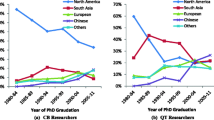Abstract
This research explores empirically a socioeconomic/equity issue that has been extensively investigated in many areas, but never marketing—the so-called “earnings gap.” Specifically, the study investigates income differences between men and women in marketing, while controlling for differences in business experience, level of education, corporate level, type of industry, and size of firm. The research focuses on three areas in marketing: (1) marketing management, (2) marketing research, and (3) advertising agency management. Findings indicate that there is an “earnings gap” for marketers. Importantly, however, the data show that a substantial portion of the gap can be explained by variables other than sex.
Similar content being viewed by others
References
Anderson, Beverlee B. 1972. “Working Women versus Non-Working Women: A Comparison of Shopping Behavior.” In1972 Combined Proceedings, p. 355–359. Eds. Boris W. Becker and Helmut Becker. Chicago: American Marketing Association.
Bartos, Rena. 1977. “The Moving Target: The Impact of Women’s Employment on Consumer Behavior.”Journal of Marketing 41 (3): 31–37.
Blau, Francine D., and Marianne A. Ferber. 1986.The Economics of Women, Men and Work. Englewood Cliffs, NJ: Prentice-Hall.
Blau, Francine D., and Andrea H. Beller. 1988. “Trends in Earnings Differentials by Gender, 1971–1981.”Industrial and Labor Relations Review 41(4): 513–529.
Bridges, W.P. 1980, “Industry Marginality and Female Employment: A New Approach.”American Sociological Review 45: 58–75.
Daymont, T.N., and P.J. Andrisani. 1984. “Job Preferences, College Major and the Gender Gap in Earnings.”Journal of Human Resources 19: 408–428.
Douglas, Susan P. 1976a. “Cross-National Comparisons and Consumer Stereotypes: A Case Study of Working and Non-Working Wives in the U.S. and France.”Journal of Consumer Research: 12–20.
—. 1976b. “Working Wife vs. Non-Working Wife Families: A Basis for Segmenting Grocery Markets?” InAdvances in Consumer Research 3, pp. 191–198. Ed. Beverlee B. Anderson. Ann Arbor, MI: Association for Consumer Research.
Employment and Earnings. January 1989. U.S. Department of Labor, Bureau of Labor Statistics.
Ferber, Marianne A., and Helen M. Lowry. 1977. “Women’s Place: National Differences in the Occupational Mosaic.”Journal of Marketing 41(3): 23–30.
Fraker, S. 1984. “Why Women Aren’t Getting to the Top.”Fortune. April 16: 40–43.
Goldberger, Arthur S. 1984. “Reverse Regression and Salary Discrimination.”Journal of Human Resources XIX(3): 291–318.
Green, Carole A., and Marianne A. Ferber. 1984. “Employment Discrimination: An Empirical Test of Forward Versus Reverse Regression.”The Journal of Human Resources XIX(4): 557–569.
Levin, Michael. 1987.Feminism and Freedom. New Brunswick, NJ: Transaction Books.
McCall, Suzanne H. 1977. “Meet the Work Wife”.Journal of Marketing 41(3): 55–65.
Olson, josephine and Irene Hanson Frieze. 1987. “Income Determinants for Women in Business”. InWomen and Work: An Annual Review 1: 173–206. Eds. L. Larwood, A.H. Stromberg and B.A. Gutek.
Olson, Josephine, and Irene Hanson Frieze. 1989. “Job Interruptions and Part-Time Work: Their Effect on MBAs’ Income”.Industrial Relations 28(3): 373–386.
O’Neill, J. 1985. “The Trend in the Male-Female Wage Gap in the United States.”Journal of Labor Economics 3(1): S91–116.
Parcel, T.L., and C.W. Mueller. 1983.Ascription and Labor Markets: Race and Sex Differences in Earnings. New York: Academic.
Reilly, Michael D. 1982. “Working Wives and Convenience Consumption”.Journal of Consumer Research 8: 407–418.
Reynolds, Fred D., Melvin R. Crask, and William D. Wells. 1977. “The Modern Feminine Lifestyle.”Journal of Marketing 41(3):38–45.
Roberts, Mary Lou, and Lawrence H. Wortzel. 1979. “New Life-Style Determinants of Women’s Food Shopping Behavior.”Journal of Marketing 43: 28–39.
Schwartz, F.N. 1983. “From Getting In to Getting On.”Working Women September: 131–133.
Smith, J.P., and M.P. Ward. 1984.Women’s Wages and Work in the 20th Century. Santa Monica, CA: Rand Corporation.
Strober, Myra H., and Charles B. Weinberg. 1980. “Strategies Used by Working and Non-Working Wives to Reduce Time Pressures.”Journal of Consumer Research 6: 338–348.
Wall Street Journal. “Youth, College Narrows Pay Gap a Bit for Women”. November 17, 1989, B1.
Vitell, Scott. 1986.Marketing Ethics: Conceptual and Empirical Foundations of a Positive Theory of Decision Making in Marketing Situations Having Ethical Content. Unpublished Ph.D. Dissertation, Texas Tech University.
Zeithaml, Valarie A. 1985. “The New Demographics and Market Fragmentation.”Journal of Marketing 49(3): 64–75.
Zeitz, B. 1983. “The Crisis in Middle Management.”Working Women September: 133–136.
Author information
Authors and Affiliations
Rights and permissions
About this article
Cite this article
Kiecker, P.L., Hunt, S.D. & Chonko, L.B. Gender, income differences, and marketing: Examining the “earnings gap” in three areas of marketing. JAMS 19, 77–82 (1991). https://doi.org/10.1007/BF02725999
Issue Date:
DOI: https://doi.org/10.1007/BF02725999




